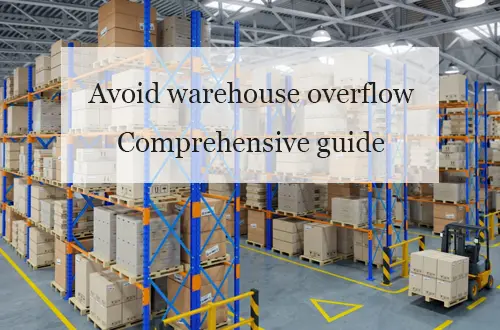A Comprehensive Guide to Avoiding Warehouse Overflows
Are you still troubled by problems such as inventory overflow leading to occupied funds, increased warehousing costs, expired or damaged products, etc. Effective inventory management is to fully meet consumer needs and experience while controlling inventory within a reasonable range. So what should we do?
Inventory overflow means that the inventory exceeds the carrying capacity of the warehouse, that is, the actual quantity of inventory exceeds the expected or planned quantity, resulting in excess inventory, occupying warehouse space, increasing inventory costs, and even affecting the circulation of goods and inventory turnover rate.
The main reasons for inventory overflow are
Order volume surges
A surge in warehouse orders will directly lead to an increase in inventory demand, exceeding the warehouse's carrying capacity.
Unbalanced purchase, sales and inventory
The purchase volume is too large, or the sales speed slows down, resulting in inventory backlog.
Forecast is inaccurate
Accurate demand forecasting is a core element of warehouse management. If a company cannot accurately predict the demand for its products, it may result in over-purchasing, which can lead to overstocking or even overflowing of warehouse inventory.
Inefficient use of space
Proper planning and management of warehouse space is crucial. Improper space management may result in insufficient storage areas, difficulty in restocking and inventory management, or even accumulation of existing inventory, resulting in inefficient use of warehouse space.
Lack of inventory visibility
Continuous monitoring of inventory levels is necessary. Failure to understand and grasp inventory status in a timely manner may lead to out-of-stock or over-stock problems. Without a monitoring system in place, warehouse managers may not notice that warehouse capacity is approaching capacity until the problem becomes serious.
Inadequate warehousing system
An outdated or inefficient warehouse management system (WMS) can negatively impact operational efficiency. Modern WMS solutions provide real-time tracking, inventory visibility, and data analytics that help prevent inventory overflows and improve warehouse operations.
How to avoid warehouse overflow?
Responses to inventory overflows
Optimize warehouse management
Use the warehouse management system (WMS) to control inventory in real time, effectively control inventory turnover from receiving, storage, and outgoing warehouses to ensure the balance of purchase, sales, and storage.
Optimize warehouse layout
A well-designed warehouse layout is the basis for efficient use of space. Regularly review and optimize floor plans to accommodate changes in inventory levels and product demand. Consider implementing a dynamic storage system that can be easily adjusted to meet changing storage needs.

The key to avoiding warehouse overflow is to maximize vertical space with tall storage racks and shelving units. Implementing vertical storage solutions allows warehouses to fully utilize their available space, eliminating the need for horizontal expansion, which can be costly and logistically challenging.
Delicate management
Carry out refined management of existing materials and finished products to achieve accurate stocking, timely processing of backlogged materials and timely replenishment, etc.
Analyze product locations to ensure fast-moving items are easily accessible, reducing the need for excessive movement within the warehouse. This strategic arrangement minimizes the risk of storage overflow by streamlining the order fulfillment process.
real-time tracking system
Implementing a real-time tracking system to continuously monitor inventory levels provides instant visibility into inventory levels, allowing warehouse managers to address potential overflow issues before proactive escalation.
Forecast market demand
Invest in advanced inventory management systems that leverage data analytics and artificial intelligence for accurate demand forecasting. By understanding future demand trends, warehouse managers can optimize storage space and avoid the pitfalls of inventory overload. Use data analysis and market trends to more accurately predict demand and avoid over-purchasing and inventory backlogs.
Optimize supply chain
Establish good cooperative relationships with suppliers to ensure smooth logistics and avoid supply chain interruptions caused by insufficient or excess inventory.
Set optimal inventory levels
By setting optimal inventory levels, companies can avoid excess inventory and ensure there is enough inventory to meet demand.
Process backlog of goods in a timely manner
When backlogged goods are discovered, they should be dealt with promptly to avoid occupying warehouse space and increasing inventory costs. Minimize excess inventory, prevent inventory overflow and reduce the risk of inventory overload. Implement a systematic approach to managing and liquidating this inventory to prevent it from taking up valuable storage space and causing warehouse overflows.
Strategic partnerships with 3PL providers
Consider forming strategic partnerships with third-party logistics (3PL) providers to optimize storage and distribution. 3PL providers often have the expertise and resources to effectively manage inventory, thereby reducing the risk of warehouse overflow.
Regular inventory checks
Regular inventory checks and cycle counts are performed to determine differences between recorded and actual inventory levels. This proactive approach quickly corrects any issues and prevents overflow storage issues from escalating.
To improve the problem of inventory overflow, companies need to understand the company's sales capabilities, storage capabilities, and turnover speed, and maintain the balance of purchase, sales, and inventory through measures such as optimizing warehouse management, refined management, forecasting market demand, and optimizing the supply chain. This can ensure the normal operation of the enterprise's warehouse and improve economic benefits.





